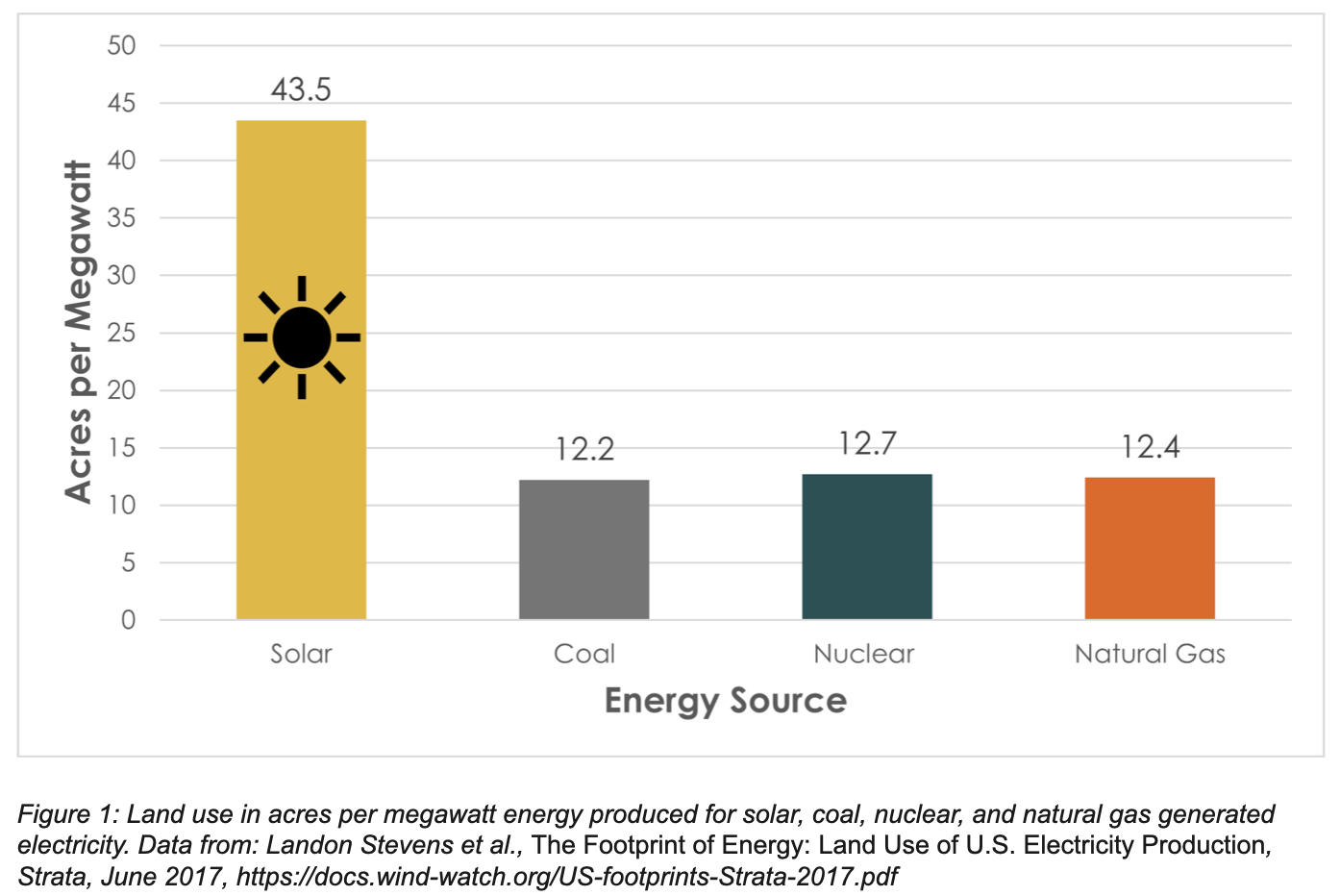“Any apples-to-apples comparison of solar energy to alternative sources of power must account for all environmental impacts, not just carbon dioxide emissions at the point of generation.”
Quick Bullets
- Solar energy does not emit air pollution or greenhouse gases at the point of generation.
- Solar power requires three times as much land per megawatt of electricity produced than coal, natural gas, or nuclear.[1]
- Solar panels create 300 times as much toxic waste per unit of energy produced as nuclear.[2]
- Solar panels and associated battery infrastructure usually contain toxic materials like lead and cadmium in quantities much higher than other energy sources.
Land Impacts
Solar energy is electricity or thermal energy generated by sunlight striking either photovoltaic (PV) panels for electricity generation, or Concentrating SolarThermal Power (CSP), which concentrates solar radiation for use as either electricity or thermal (heat) energy.
Power generation from solar does not emit air pollutants or greenhouse gases at the point of generation, but, as with all energy sources, there are environmental impacts.
According to Strata, solar energy requires an estimated 43.5 acres per megawatt of power produced, when mining, disposal, transmission, and the “footprint” of the facility is considered.[3] This land requirement is more than three times larger than coal, natural gas, or nuclear, which require about 12 acres per megawatt. Unlike wind, land for PV and CSP solar power plants is unusable for other purposes.
The materials and minerals used to manufacture solar panels must be mined. Because most of these resources are widely dispersed, rather than concentrated in dense pockets at single locations, a great deal of soil and rock—referred to as overburden—must be excavated for each small amount of critical mineral extracted.
Problems with Waste
Many of the materials contained in solar panels, including lead and cadmium, are classified by the U.S. Environmental Protection Agency as hazardous waste.[4] One study by Environmental Progress found that, when generating the same amount of energy as a nuclear plant, solar panels create at least 300 times as much toxic waste per unit of energy.[5]
If energy from solar panels is not used immediately, it is stored in large battery farms that create their own waste problems. In countries where lead batteries are often used, such as parts of Asia, lead pollution is a serious concern. For example, a study published in Energy Policy found that the batteries associated with solar power in India and China could produce more than 2.4 million tons of lead pollution.[6]
Disposal of solar panels is also a major issue because they are nearly impossible to recycle and the sheer size of these objects requires huge spaces in landfills. Several environmental groups have found that solar panels in landfills likely leach toxins into the soil. A report by the International Renewable Energy Agency estimates there were 250,000 metric tons of solar panel waste in the world in 2016, and that this number would reach 78 million metric tons by 2050.[7]

Harm to Animals
Solar power plants also pose a threat to birds and many other animals. Birds are literally incinerated in the superheated air surrounding CSP plants’ receiver towers. One CSP plant in the Mojave Desert, for example, is estimated to kill as many as 6,000 birds annually.[8] Mistaking PV arrays for bodies of water, some birds also die on collision with panels, in a phenomenon called the solar “lake effect.” [9]
Environmentalists also point out that protected species like the Mojave Desert tortoise are threatened by large solar projects in Nevada. [10] Because solar power plants require thousands of acres, biologists warn that they could irreparably damage the ability of the grounddwelling tortoise to migrate and recover its population.
Any apples-to-apples comparison of solar energy to alternative sources of power must account for all environmental impacts, not just carbon dioxide emissions at the point of generation.
Endnotes
[1] Landon Stevens et al., The Footprint of Energy: Land Use of U.S. Electricity Production, Strata, June 2017,
https://docs.wind-watch.org/US-footprints-Strata-2017.pdf
[2] Mark Nelson and Jemin Desai, “Are We Headed for a Solar Waste Crisis?” Energy Central, June 28, 2017,
https://energycentral.com/c/ec/are-we-headed-solar-waste-crisis
[3] Landon Stevens et al., The Footprint of Energy: Land Use of U.S. Electricity Production.
[4] Environmental Protection Agency, “End-of-Life Solar Panels: Regulations and Management,” Last updated August 28, 2022,
https://www.epa.gov/hw/end-life-solar-panels-regulations-and-management
[5] Mark Nelson and Jemin Desai, “Are We Headed for a Solar Waste Crisis?”
[6] Perry Gottesfeld and Christopher Cherry, “Lead Emissions from Solar Photovoltaic Energy Systems in China and India,” Energy Policy, 2011, Vol. 39, Issue 9,
https://www.sciencedirect.com/science/article/abs/pii/S0301421511004770?via%3Dihub
[7] Stephanie Weckend et al., “End-of-Life Management: Solar Photovoltaic Panels,” IRENA, June 2016,
https://www.irena.org/publications/2016/Jun/End-of-life-management-Solar-Photovoltaic-Panels
[8] Louis Sahagun, “This Mojave Desert solar plant kills 6,000 birds a year. Here’s why that won’t change any time soon,” Los Angeles Times, September 2, 2016
https://www.latimes.com/local/california/la-me-solar-bird-deaths-20160831-snapstory.html
[9] John Upton, “Solar Farms Threaten Birds,” Scientific American, August 27, 2014,
https://www.scientificamerican.com/article/solar-farms-threaten-birds/
[10] Bobby Magill, “Massive Desert Solar Project ‘Experiment’ in Tortoise Survival,” Bloomberg Law, January 9, 2020,
https://news.bloomberglaw.com/environment-and-energy/massive-desert-solar-project-experiment-in-tortoise-survival
“Any apples-to-apples comparison of solar energy to alternative sources of power must account for all environmental impacts, not just carbon dioxide emissions at the point of generation.”
Quick Bullets
- Solar energy does not emit air pollution or greenhouse gases at the point of generation.
- Solar power requires three times as much land per megawatt of electricity produced than coal, natural gas, or nuclear.[1]
- Solar panels create 300 times as much toxic waste per unit of energy produced as nuclear.[2]
- Solar panels and associated battery infrastructure usually contain toxic materials like lead and cadmium in quantities much higher than other energy sources.
Land Impacts
Solar energy is electricity or thermal energy generated by sunlight striking either photovoltaic (PV) panels for electricity generation, or Concentrating SolarThermal Power (CSP), which concentrates solar radiation for use as either electricity or thermal (heat) energy.
Power generation from solar does not emit air pollutants or greenhouse gases at the point of generation, but, as with all energy sources, there are environmental impacts.
According to Strata, solar energy requires an estimated 43.5 acres per megawatt of power produced, when mining, disposal, transmission, and the “footprint” of the facility is considered.[3] This land requirement is more than three times larger than coal, natural gas, or nuclear, which require about 12 acres per megawatt. Unlike wind, land for PV and CSP solar power plants is unusable for other purposes.
The materials and minerals used to manufacture solar panels must be mined. Because most of these resources are widely dispersed, rather than concentrated in dense pockets at single locations, a great deal of soil and rock—referred to as overburden—must be excavated for each small amount of critical mineral extracted.
Problems with Waste
Many of the materials contained in solar panels, including lead and cadmium, are classified by the U.S. Environmental Protection Agency as hazardous waste.[4] One study by Environmental Progress found that, when generating the same amount of energy as a nuclear plant, solar panels create at least 300 times as much toxic waste per unit of energy.[5]
If energy from solar panels is not used immediately, it is stored in large battery farms that create their own waste problems. In countries where lead batteries are often used, such as parts of Asia, lead pollution is a serious concern. For example, a study published in Energy Policy found that the batteries associated with solar power in India and China could produce more than 2.4 million tons of lead pollution.[6]
Disposal of solar panels is also a major issue because they are nearly impossible to recycle and the sheer size of these objects requires huge spaces in landfills. Several environmental groups have found that solar panels in landfills likely leach toxins into the soil. A report by the International Renewable Energy Agency estimates there were 250,000 metric tons of solar panel waste in the world in 2016, and that this number would reach 78 million metric tons by 2050.[7]

Harm to Animals
Solar power plants also pose a threat to birds and many other animals. Birds are literally incinerated in the superheated air surrounding CSP plants’ receiver towers. One CSP plant in the Mojave Desert, for example, is estimated to kill as many as 6,000 birds annually.[8] Mistaking PV arrays for bodies of water, some birds also die on collision with panels, in a phenomenon called the solar “lake effect.” [9]
Environmentalists also point out that protected species like the Mojave Desert tortoise are threatened by large solar projects in Nevada. [10] Because solar power plants require thousands of acres, biologists warn that they could irreparably damage the ability of the grounddwelling tortoise to migrate and recover its population.
Any apples-to-apples comparison of solar energy to alternative sources of power must account for all environmental impacts, not just carbon dioxide emissions at the point of generation.
Endnotes
[1] Landon Stevens et al., The Footprint of Energy: Land Use of U.S. Electricity Production, Strata, June 2017,
https://docs.wind-watch.org/US-footprints-Strata-2017.pdf
[2] Mark Nelson and Jemin Desai, “Are We Headed for a Solar Waste Crisis?” Energy Central, June 28, 2017,
https://energycentral.com/c/ec/are-we-headed-solar-waste-crisis
[3] Landon Stevens et al., The Footprint of Energy: Land Use of U.S. Electricity Production.
[4] Environmental Protection Agency, “End-of-Life Solar Panels: Regulations and Management,” Last updated August 28, 2022,
https://www.epa.gov/hw/end-life-solar-panels-regulations-and-management
[5] Mark Nelson and Jemin Desai, “Are We Headed for a Solar Waste Crisis?”
[6] Perry Gottesfeld and Christopher Cherry, “Lead Emissions from Solar Photovoltaic Energy Systems in China and India,” Energy Policy, 2011, Vol. 39, Issue 9,
https://www.sciencedirect.com/science/article/abs/pii/S0301421511004770?via%3Dihub
[7] Stephanie Weckend et al., “End-of-Life Management: Solar Photovoltaic Panels,” IRENA, June 2016,
https://www.irena.org/publications/2016/Jun/End-of-life-management-Solar-Photovoltaic-Panels
[8] Louis Sahagun, “This Mojave Desert solar plant kills 6,000 birds a year. Here’s why that won’t change any time soon,” Los Angeles Times, September 2, 2016
https://www.latimes.com/local/california/la-me-solar-bird-deaths-20160831-snapstory.html
[9] John Upton, “Solar Farms Threaten Birds,” Scientific American, August 27, 2014,
https://www.scientificamerican.com/article/solar-farms-threaten-birds/
[10] Bobby Magill, “Massive Desert Solar Project ‘Experiment’ in Tortoise Survival,” Bloomberg Law, January 9, 2020,
https://news.bloomberglaw.com/environment-and-energy/massive-desert-solar-project-experiment-in-tortoise-survival


